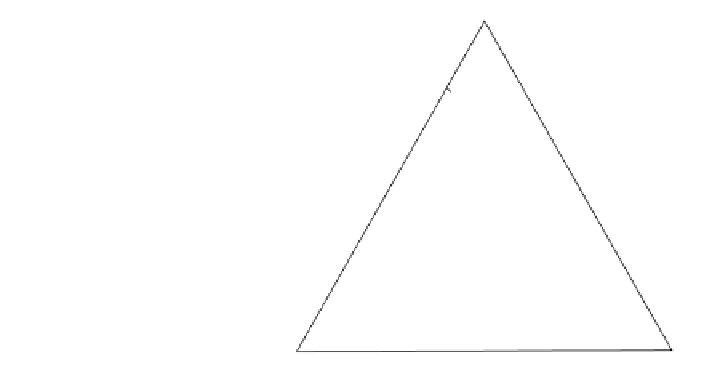Geology Reference
In-Depth Information
9.1 Study of the System Diopside
Nepheline
Leucite The
-
-
Join Diopside
Nepheline
Sanidine Under Atmospheric
-
-
Pressure
The system diopside
sanidine studied by of Platt and Edgar (1971;
Fig.
9.1
) is important in establishing the paragenetic relationship between the rocks
belonging to melanephelinite series and phonolites. They established that all phases
in this system are solid solutions. If the presence of small amounts of possible Ca-
Tschermak
-
nepheline
-
is molecule is ignored, the join can be treated as quinary, i.e., a part of
the system NaAlSiO
4
-
'
SiO
2
. This join cuts through the pri-
mary phase volumes of forsterite
ss
, diopside
ss
, nepheline
ss
and leucite
ss
. Forsterite
ss
has a reaction relation with the liquid. The
KAlSiO
4
-
CaO
MgO
-
-
field of leucite
ss
is related to the
incongruent melting of sanidine
ss
, thus the former should react with the silica-rich
liquid at low temperatures to form alkali feldspar. In the KAlSi
3
O
8
-poor part of the
system there is a primary phase
field of forsterite
ss
. The assemblages near the four
phase points and below the solidus, consist of the following phases:
1. nepheline
ss
-
diopside
ss
-
leucite
ss
-
l (point B; Fig.
9.1
),
2. forsterite
ss
-
l (point A; Fig.
9.1
),
3. nepheline
ss
+ diopside
ss
+ leucite
ss
+ alkali feldspar (between 950 and 1,000
nepheline
ss
-
diopside
ss
-
°
C
C leucite is eliminated.
4. nepheline
ss
+ diopside
ss
+ alkali feldspar (below 900
central portion) and below 900
°
°
C), and
5. nepheline
ss
+ diopside
ss
+ melilite (near the nepheline
diopside join containing
-
<5 wt% sanidine).
Assemblages (1
-
5) correspond to nepheline leucitite, olivine nephelinite,
nepheline
-
leucite
phonolite,
nepheline
phonolite,
and melilite
-
nephelinite,
respectively. After elimination of leucite and appearance of K
-
Na feldspar, the
Fig. 9.1 Phase relation in the
system diopside
nepheline
-
sanidine under atmospheric
pressure (after Platt and Edgar
1971)
-



















































































































































Search WWH ::

Custom Search